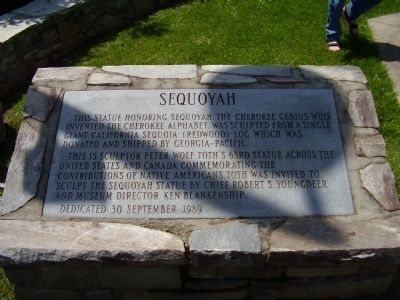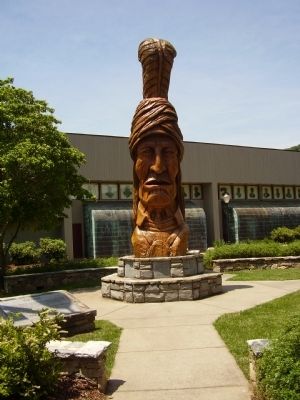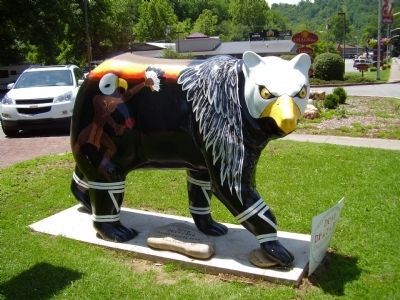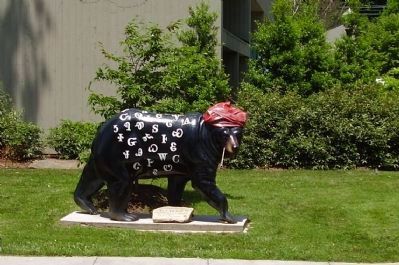Cherokee in Swain County, North Carolina — The American South (South Atlantic)
Sequoyah
Erected 1989.
Topics. This historical marker is listed in this topic list: Native Americans. A significant historical date for this entry is September 30, 1989.
Location. 35° 29.081′ N, 83° 18.961′ W. Marker is in Cherokee, North Carolina, in Swain County. Marker is on County Route 1361. Touch for map. Marker is in this post office area: Cherokee NC 28719, United States of America. Touch for directions.
Other nearby markers. At least 8 other markers are within walking distance of this marker. Museum of the Cherokee Indian (a few steps from this marker); Trail of Tears (within shouting distance of this marker); Paint Clan (within shouting distance of this marker); Deer Clan (within shouting distance of this marker); Qualla Arts and Crafts Mutual, Inc. (within shouting distance of this marker); Wolf Clan (about 500 feet away, measured in a direct line); Wild Potato Clan (about 500 feet away); Blue Clan (about 600 feet away). Touch for a list and map of all markers in Cherokee.
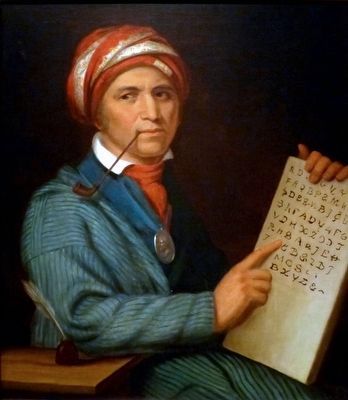
Photographed By Allen C. Browne, February 16, 2015
5. Sequoyah
This c. 1830 portrait of Sequoyah by Henry Inman after Charles Bird King hangs in the National Portrait Gallery in Washington, DC.
“Born Cherokee town of Tuskegee, eastern Tennessee, Sequoyah, the son of a Cherokee chief's daughter and a fur trader from Virginia, was a warrior and hunter and, some say, a silversmith. For twelve years he worked to devise a method of writing for the Cherokee language. His syllabary of eighty-five symbols representing vowel and consonant sounds was approved by the Cherokee chiefs in 1821. The simple utilitarian system made possible a rapid spread of literacy throughout the Cherokee nation. Medicine men set down ceremonies for healing, divination, war, and traditional ball games; missionaries translated hymns and the New Testament into the native language; and in 1828 the Cherokee Phoenix, a weekly bilingual newspaper, began publication at New Echota, Georgia.
The original portrait of Sequoyah, commissioned by Thomas McKenney and painted by Charles Bird King, was destroyed by the fire that swept through the Smithsonian Castle building in January 1865.” — National Portrait Gallery
“Born Cherokee town of Tuskegee, eastern Tennessee, Sequoyah, the son of a Cherokee chief's daughter and a fur trader from Virginia, was a warrior and hunter and, some say, a silversmith. For twelve years he worked to devise a method of writing for the Cherokee language. His syllabary of eighty-five symbols representing vowel and consonant sounds was approved by the Cherokee chiefs in 1821. The simple utilitarian system made possible a rapid spread of literacy throughout the Cherokee nation. Medicine men set down ceremonies for healing, divination, war, and traditional ball games; missionaries translated hymns and the New Testament into the native language; and in 1828 the Cherokee Phoenix, a weekly bilingual newspaper, began publication at New Echota, Georgia.
The original portrait of Sequoyah, commissioned by Thomas McKenney and painted by Charles Bird King, was destroyed by the fire that swept through the Smithsonian Castle building in January 1865.” — National Portrait Gallery
Credits. This page was last revised on June 16, 2016. It was originally submitted on June 7, 2009, by Stanley and Terrie Howard of Greer, South Carolina. This page has been viewed 1,044 times since then and 36 times this year. Photos: 1, 2, 3, 4. submitted on June 7, 2009, by Stanley and Terrie Howard of Greer, South Carolina. 5. submitted on November 14, 2015, by Allen C. Browne of Silver Spring, Maryland. • Craig Swain was the editor who published this page.
